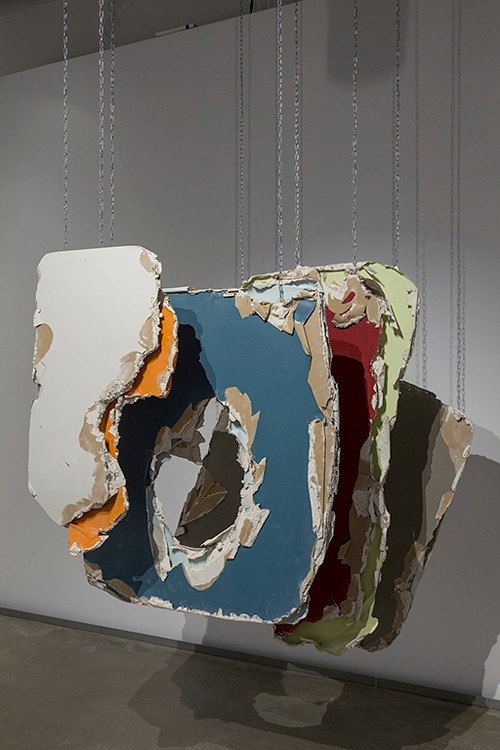COMBINE 2012: Annual Undergraduate Student Exhibition
Author: Erika Couto
Artist: Ingrid Tremblay
 Ingrid Tremblay, Destruction constructive, 2012, sculpture, gyproc, acrylic, wood, 123 x 160 x 102 cm. Photo: Guy L'Heureux
Ingrid Tremblay, Destruction constructive, 2012, sculpture, gyproc, acrylic, wood, 123 x 160 x 102 cm. Photo: Guy L'Heureux
About the artist
Situated within a Minimalist tradition valuing three-dimensionality, Destruction constructive allows Ingrid Tremblay to build upon her fascination with reconceptualised debris. Her sculptural works rely on the accumulation of scraps and found materials, privileging remnants that are usually abandoned without any thought. Tremblay sees in these objects the potential to create new forms and generate new life out of things that have already served their traditional purposes.
Tremblay’s sculpture draws strong parallels to the works of Gordon Matta-Clark, renowned for his famous “building cuts” in which the architect would “cut” fragments out of buildings, exposing their interiors to the outside world. Like Matta-Clark, Tremblay’s work is immersed in the possibilities of entropy, or the gradual decline of order and predictability. Destruction constructive re-envisions this form of architectural non-conformism within traditional art world institutions. Tremblay brings her rebellion away from the streets and into the gallery, creating kinetic, dynamic forms that challenge the viewer’s notions of debris.
The thin chains that suspend Tremblay’s Destruction constructive as it hangs at eye level from the ceiling are a small hint of restraint in a sculpture that seems to have been formed from pure chaos. It is in this juxtaposition between the disarray of Tremblay’s materials and the careful way that they are suspended that new spaces are formed. Disorder becomes a vehicle for an exploration of materiality as acrylic-painted gyprock and wood are combined in a sculpture that measures over five feet in both width and depth. The work builds from destruction, destroys to reveal, and shows finesse in its brutality.
The gyprock panels function both as individual works and as a singular whole. The viewer can look through the piece but can also stop to examine each individual part, encouraged by Destruction constructive’s positioning just a few feet above the ground. The work is clearly meant to let the eye roam in a liberal examination of forms and textures; rough and smooth, cracked and whole, there is an almost endless array of possibilities for exploration. It is from its seeming lack of polish that the work derives its visual complexity. This is not a sculpture that can be seen at a simple glance. It demands attention and asserts its presence through its impressive size. To examine each portion of gyprock, the viewer is forced to move, to relocate, to bend to the whims of the massive sculpture. The whole is formed by the accumulation of its carefully hung parts.
There is no avoiding Destruction constructive in a space. Tremblay has turned disjointed rubble into a skilfully assembled work that challenges the mind and body. Its nearly floor-to-ceiling height creates a barrier that menaces the viewer and forces an acknowledgement of its presence. The piece is confrontational and violent, yet Tremblay’s sculpture is also inviting, seductive in its unruliness. Every contour provides a new possibility for exploration, every colour complements those surrounding it and every scrap of debris is given new purpose.
Biographies
Erika Couto
Erika Couto will graduate in 2013 with a BFA in Art History & Film Studies. An avid lover of electroacoustics, textiles, and sculpture, her current research projects explore Pacific Northwest textiles and the documentation of sound in the visual arts. Highly invested in providing opportunities to undergraduates to highlight their research, Erika is an Associate Editor with the Concordia University Journal of Art History and an organizer of the Concordia University Undergraduate Art History conference. She has also been a councilor with the Fine Arts Student Alliance since 2011. She hopes to continue her studies at the graduate level in the near future.
Ingrid Tremblay
Ingrid Tremblay is currently completing a Bachelor of Fine Arts (Major Studio Arts) at Concordia University, after obtaining a degree in speech therapy. She recently participated in group exhibitions The Body and Its presence (Coatcheck Gallery) Pinakotheke or the art of (not) talking about temperature (AB gallery of the Belgo Building) Subject to change (Project Space Gallery, Art Matters Festival ), Le jeu dans l’art (Galerie Art Mûr), Pinakotheke or the art of stuffed squash with friends (Galerie Crystal Racine) and Alive and Kicking (Eastern Bloc gallery, Art Matters festival). She also completed two residencies at the Parisian artists’ center of 59 Rivoli. The artist's works combine various artistic mediums and deal with oppositions and paradoxes in ideas and in the composition, for example, by to build destruction, brutalize to weaken, to hide something so as to reveal it.
